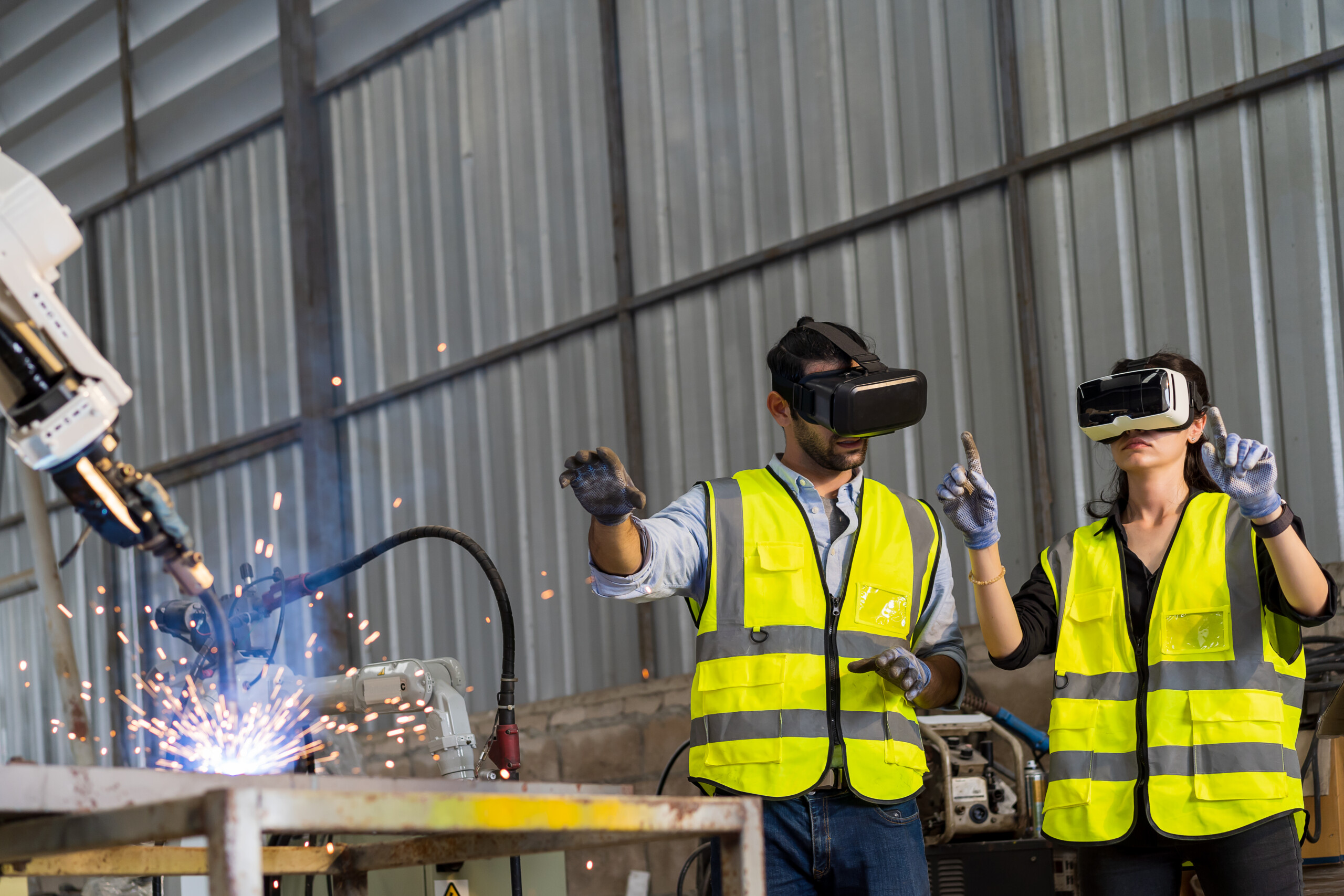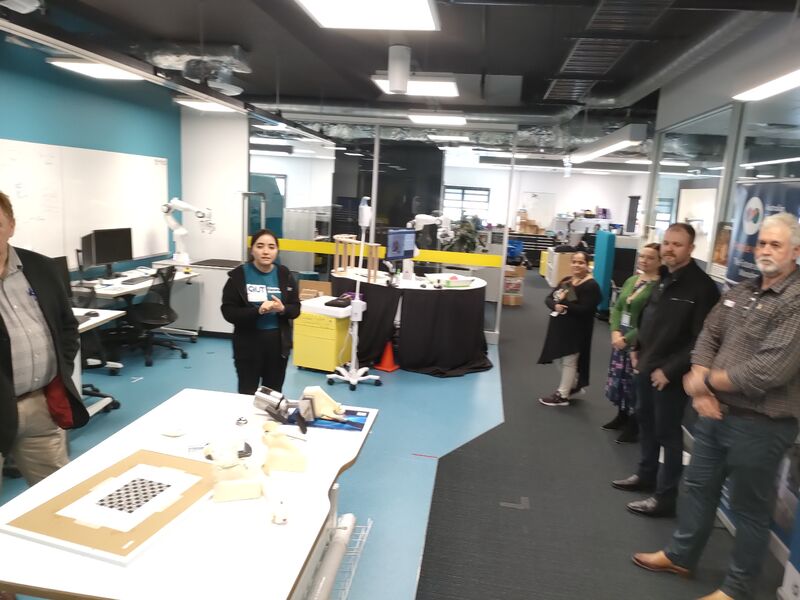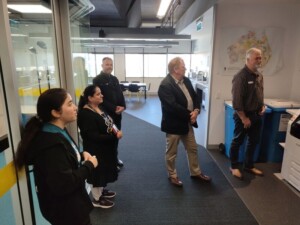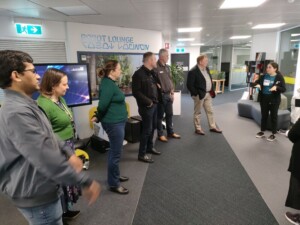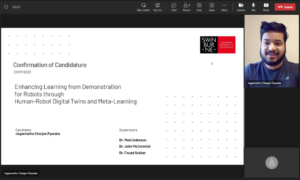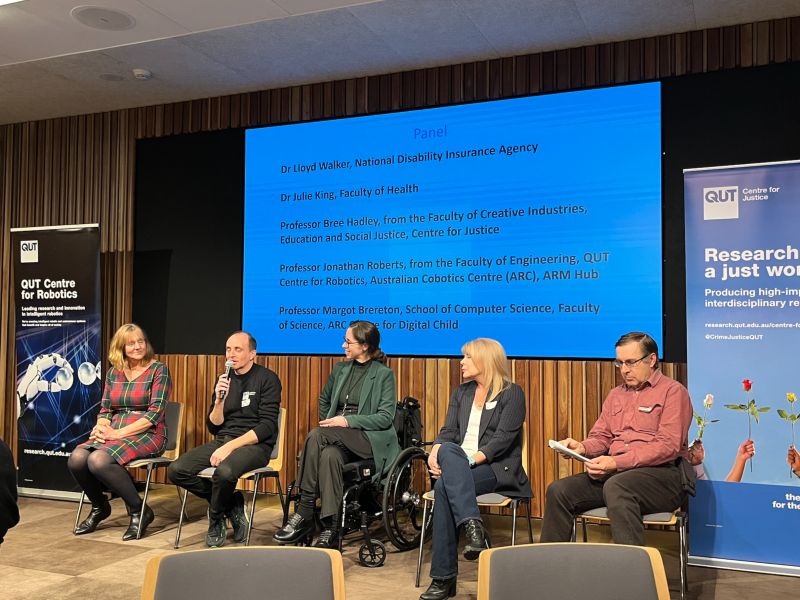Written by Dr Marc Carmichael and Louis Fernandez from the Australian Cobotics Centre.
Collaborative robots, or cobots for short, have gained significant attention in recent years due to their potential to work in close proximity and collaboration with humans. However, despite their name, there seems to be a lack of actual collaboration between humans and cobots in many, if not most, industrial settings.
The Australian Cobotics Centre aims to transform the Australian manufacturing industry through the deployment of collaborative robots, and in a recent webinar we discussed how significant benefits may be possible if more sophisticated forms of collaboration between humans and cobots can be practically achieved.
In this article we discuss this, starting with the basics of cobots, exploring the untapped potential of cobot-human collaboration, and how we hope to develop new ways of enabling humans and cobots to collaborate.
Defining Cobots and Industrial Robots:
Before we talk about the untapped potential of cobot-human collaboration, let’s start by understanding the basic differences between cobots and regular industrial robot arms.
Industrial robot arms are normally big, heavy machines you might see in factories or other environments that have repetitive and predictable jobs. Industrial robots are great at lifting heavy things quickly and accurately. However, this is also what makes them dangerous around people, so they need to be kept away from them.
On the other hand, cobots are much smaller and lighter. They also have technology that lets them ‘feel’ their surroundings. These functionalities allow them to work alongside humans. On top of that, they’re easier to program than industrial robots. This allows them to be quickly put to work on different tasks and makes them good for flexible jobs.
The Current State of Cobot Collaboration:
Even though cobots are capable of working beside people, they don’t very often really work with people. Feedback from experts and users, as well as research literature, have observed that cobots are being used more like traditional industrial robots. For example, cobots are often used in pick and place or palletising jobs. These applications look much like how industrial robots work, except cobots don’t need the protective cage around them. This raises the question: “Are we really using cobots to their full potential?”
Don’t get me wrong, using cobots as cageless industrial robots has great advantages. Not needing a cage means you have more space on your shop floor for other equipment, and you spend less time during the installation process. In addition, cobots are generally easier and faster to program compared to industrial robots. For example, cobots can be programmed by physically grabbing and moving their arm to show them where to go. This easy form of programming allows cobots to be easily set up and deployed, a benefit for small businesses getting into automation. Plus, cobots are getting better, with some having more reach and strength to handle different jobs. As they improve, we might see cobots and robots becoming harder to tell apart, and using cobots like cageless industrial robots might become common.
However, using cobots like industrial robots doesn’t make the most of what they can do. We should explore the challenges and opportunities of making cobot-human collaboration better.
Defining Levels of Human-Robot Collaboration:
Before we continue, it is important to define collaboration in the context of cobots. What collaboration means depends on the discipline, and terms are often used inconsistently or interchangeably. A classification that is becoming increasingly common, and which we personally like, is the following:
Level 0: Cell – this is the traditional approach used in industrial robots where humans are isolated from the robot, often by physical caging or fences.
Level 1: Co-existence – the human and cobot share the workspace, but work together on a task in a sequential fashion. For example, a cobot performs a packing task, with a human only entering the workspace to restock items. Sensors such as a safety area scanner are used to slow/stop the cobot when someone is in the vicinity.
Level 2: Co-operation – the human and cobot operate in shared space, with the worker guiding or influencing cobot operation via inputs (e.g. force, speech, gesture, etc). Cobot may adapt its motion based on human measurements.
Level 3: Collaboration – the human and cobot cooperate on joint task. Cobot learns and adapts by observing humans, to achieve a dynamic and supportive collaboration. Human and cobot are responsive to each other in a mutually beneficial manner, where both parties actively contribute to the task at hand.
Although it is sometimes difficult to define, these definitions can help distinguish different levels of interaction and collaboration between cobots and humans.
Exploring the Potential Gains and Barriers to Collaboration:
We would consider most cobot use cases to be Level 1 collaboration, where other than the cobot adapting its pre-programmed routine based on the presence of a human, there is next-to-no real collaboration between the two. To rephrase the previous question that we raised: “what are we missing out on by not going after Level 2 and Level 3 collaboration?”
There are some interesting and compelling proof-of-concepts by robotics researchers that demonstrate the potential to be achieved, See Further Reading for some examples. One study estimated a potential reduction in task completion time of up to 20%, suggesting significant benefits in productivity can be unlocked. Unfortunately, there are relatively few examples of high-level collaboration that have made their way to practical use.
In our program (Human-Robot Interaction) at the Australian Cobotics Centre, our goal is to increase the scope of genuine collaboration. Our efforts are focused on novel interaction approaches using multi-sensory interfaces, gesture control devices and augmented reality which can reduce training costs, enable rapid prototyping, and make robots safer and easy to use in production tasks.
It is our belief that addressing these challenges will lead to new methodologies for enabling rich and beneficial forms of human-robot collaboration. Combined with the work of our colleagues at the Australian Cobotics Centre whose programs are addressing technical, social, and organizational challenges, we are looking forward to sharing the outcomes we achieve and are excited about the future of cobotics.
Further reading:
Michaelis, J. E., Siebert-Evenstone, A., Shaffer, D. W., & Mutlu, B. (2020). Collaborative or simply uncaged? understanding human-cobot interactions in automation. Proceedings of the 2020 CHI Conference on Human Factors in Computing Systems. https://doi.org/10.1145/3313831.3376547
Guertler, M., Tomidei, L., Sick, N., Carmichael, M., Paul, G., Wambsganss, A., Hernandez Moreno, V., & Hussain, S. (2023). When is a robot a cobot? moving beyond manufacturing and arm-based cobot manipulators. Proceedings of the Design Society, 3, 3889-3898. https://doi.org/10.1017/pds.2023.390
Kopp, T., Baumgartner, M., & Kinkel, S. (2020). Success factors for introducing industrial human-robot interaction in practice: an empirically driven framework. The International Journal of Advanced Manufacturing Technology, 112(3-4), 685-704. https://doi.org/10.1007/s00170-020-06398-0
Male, J. and Martinez-Hernandez, U. (2021). Collaborative architecture for human-robot assembly tasks using multimodal sensors. 2021 20th International Conference on Advanced Robotics (ICAR). https://doi.org/10.1109/icar53236.2021.9659382
Carmichael, M. G., Aldini, S., Khonasty, R., Tran, A., Reeks, C., Liu, D., … & Dissanayake, G. (2019). The ANBOT: an intelligent robotic co-worker for industrial abrasive blasting. 2019 IEEE/RSJ International Conference on Intelligent Robots and Systems (IROS). https://doi.org/10.1109/iros40897.2019.8967993
Zhuang, Z., Ben-Shabat, Y., Zhang, J., Gould, S., & Mahony, R. (2022). Goferbot: a visual guided human-robot collaborative assembly system. 2022 IEEE/RSJ International Conference on Intelligent Robots and Systems (IROS). https://doi.org/10.1109/iros47612.2022.9981122





 Let’s introduce
Let’s introduce 

